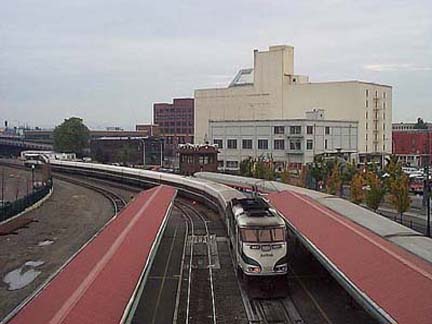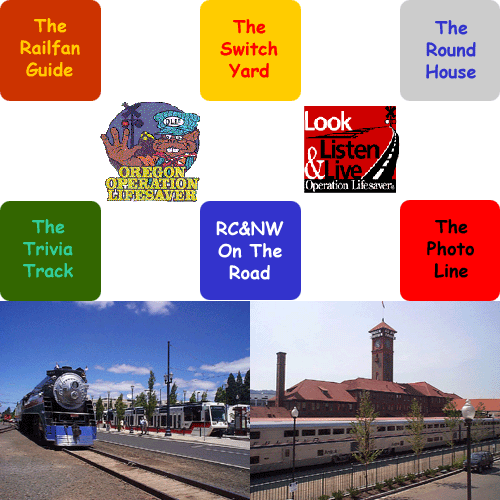 |
 |
 |
|
The Cascades are the daily passenger trains operated by Amtrak, in cooperation with the states of Oregon and Washington and the Canadian province of British Columbia, between Eugene, Ore. and Vancouver, B.C. These trains carry on the tradition of Pacific Northwest corridor services provided by the Great Northern, Northern Pacific and Union Pacific railroads, each of which contributed a train to the Portland-Seattle route, and the GN's Seattle-Vancouver, B.C. Internationals. The Cascades were initially equipped with train sets known as TALGOs. TALGO -- the Spanish acronym for Tren Articulado Ligero Goicoechea y Oriol -- is a lightweight articulated train developed by Spanish industrial engineer Alejandro Goicoechea in the 1940s. American Car and Foundry of Berwick, Pa. built the first TALGO trains in the late 1940s for service both in Spain and in the U.S. American railroads never took to them, but they turned out quite popular in Spain and provided that country's premier passenger services until the introduction of high-speed trains, based on the French TGV, in the 1990s. Amtrak and the Washington State Department of Transportation reintroduced TALGO to American passenger railroading in 1994 when they leased a 12-car trainset from Spanish National Railways. The set entered service that year on the Mt. Adams train between Seattle and Portland. This time around, the train became quite popular. Amtrak and WSDOT leased a second, 15-car TALGO in 1996. This set entered service in May 1996 as the Mt. Baker International between Seattle and Vancouver, B.C. Amtrak subsequently re-arranged the sets to provide two 13-car trains (the remaining car from the second set was a five-compartment sleeper provided for demonstration purposes only). Amtrak restructured its Pacific Northwest corridor in May 1998, moving both leased TALGO sets into Seattle-Portland-Eugene service and assigning a bi-level Superliner train to the Vancouver route. It also added a third corridor train south of Seattle, with each TALGO set making 1-1/2 round trips daily. Meanwhile, five new TALGO trains were undergoing final assembly at Pacifica Marine in Seattle. Amtrak and WSDOT had contracted with the Spanish TALGO manufacturer, Patentes Talgo S.A., to assemble the trains in the U.S. Pacifica built all five sets to U.S. operating standards (the leased trains were simply off-the-shelf Spanish TALGOs modified for U.S. service). WSDOT and Amtrak each purchased two sets. The fifth set was planned as a demonstrator and for future service in California. Pacifica also assembled several spare cars for the fleet (Washington State eventually purchased the fifth set in 2003 and named it the Mt. Adams). Amtrak and WSDOT dedicated the first set, named the Mt. Rainier, Nov. 9, 1998 and subsequently sent it to the U.S. DOT test facility in Colorado, where it successfully operated at speeds up to 124 mph. Meanwhile, two of the the other sets -- the Mt. Baker and the Mt. Hood -- operated on inaugural runs Nov. 30, 1998 between Vancouver and Seattle and Seattle and Eugene, respectively. Amtrak had planned to begin regular Cascades service with the new trains Dec. 1, 1998, but delays in receiving some interior components and final break-in testing postponed the start of regular service until Jan. 11, 1999. At that time, two of the new consists replaced the two leased sets in service on the three trains south of Seattle. The third set entered service between Seattle and Vancouver, B.C. Feb. 24, 1999. The fourth set, named Mt. Olympus, entered revenue service Sept. 2, 1999 between Seattle and Bellingham, Wash. A second run between Portland and Eugene began Oct. 6, 2000. Both leased sets eventually returned to Spain and were subsequently sold to the country of Kazakhstan in central Asia for new service there. As built, each Cascades train set consisted of twelve cars: six standard coaches, two business-class coaches, a diner-lounge, a Bistro (cafe) car, a baggage car and a power car. Amtrak and WSDOT subsequently reconfigured four of the sets with a seventh standard coach, taken from the set of spares and from the demonstration set, which had been built with two extra coaches. The interior layout complied with the Americans with Disabilities Act and included wheelchair access on one standard coach and one business-class coach in each set. The cafe car included an illuminated map of the Pacific Northwest in the ceiling, with lights showing towns in the region. The coaches included reclining seats that were equipped with stereo headphone connections and power outlets for electronic devices such as portable computers. They were also equipped with television monitors for showing movies en route. The TV monitors also show a map of the train's progress, which is tracked by a Global Positioning System receiver on board. The baggage car was also equipped with hanging racks to carry bicycles. The power car provided the heating, lighting and electrical power to the cars, freeing the locomotive to propel the train. All five trains wore a unique color scheme of green, cream and copper brown (known colloquially as the "Latte and Cream", referring to Pacific Northwest residents' love of specialty coffee). The end cars on each set (baggage car at one end, power car at the other) also had distinctive aerodynamic tail fins similar to those found on American automobiles in the 1950s (and which, when viewed on end, look like the ears on a "Batman" mask, prompting many to call the trains "Batmobiles"). The tail fins provided a streamlined match to the height of the trains' locomotives, which were significantly taller than the cars. The F59PHI locomotives originally assigned in this service were painted to match the trains, as were the converted F40PH cab cars that allow them to operate in "push-pull" service, eliminating the need to turn the trains at their end points. Amtrak subsequently assigned P42-9DC locomotives for these trains, but these wore the then-current Amtrak Phase V color scheme. The locomotive or cab car and the baggage or power car on each end also provided critical impact protection for the passenger-carrying cars in the event of a collision. Amtrak, BNSF and the State of Washington concluded an agreement with the B.C. provincial government in 2007 to extend the Portland-Seattle-Bellingham train through to Vancouver. As part of the agreement, BNSF constructed a passing siding near Colebrook, north of White Rock, B.C. to help increase the line's capacity and enable the agencies to extend the train. This extension was delayed almost a year due to a disagreement with the Canadian border services agency over the payment of fees for providing customs service. The agency agreed to waive the fees so that the service could start up in time for the 2010 Winter Olympics in Vancouver, and the train began operating Aug. 19, 2009. It provided same-day, single-seat Portland-Seattle-Vancouver service for the first time. On Feb. 26, 2010, the Oregon DOT announced that the state would purchase two 13-car TALGO sets for Cascades services. The trains, which TALGO America built at a new plant in Milwaukee, Wisc., cost $36.6 million and entered service in December 2013. Federal stimulus funds helped pay for the the trains. Like the older sets, the two new consists also have names -- the Mount Bachelor and the Mount Jefferson. These new sets do not use a NPCU, but instead have a cab car integral to the consist. This also the auxiliary power car for the train. TALGO America also built two similar 14-car trains for the Wisconsin DOT. These would have entered Hiawatha Service between Chicago and Milwaukee, and subsequently to Madison, but political changes in the Wisconsin state government resulted in the cancellation of the Madison extension and the storage of the two sets in Milwaukee before they entered service. Amtrak moved the two sets and three spare cars in May 2014 to its Beech Grove shop complex near Indianapolis. They were subsequently sold to Nigeria for service there. Construction crews rebuilt the former BNSF Nisqually Line as part of the Point Defiance Bypass project. Most of the work had been completed early in 2017, and Amtrak began running test trains on the route beginning in February. Amtrak had announced a Dec. 18, 2017 startup of revenue service on the route, including two new Portland-Seattle roundtrips. Sadly, the first revenue train on the new route, Cascades #501, derailed at nearly 80 MPH on a curve over the southbound lanes of Interstate 5 at Dupont, Wash. Three passengers died and 62 passengers and crew were injured in the tragedy, which also wrecked the Mount Adams trainset and a brand-new WSDOT SC-44 Siemens Charger locomotive. Due to ridership losses linked to the ongoing coronavirus crisis in 2020, the service was reduced to a single daily Eugene-Seattle round trip morning northbound to Seattle and mid-afternoon southbound to Eugene. Two additional round trips were restored in mid-2021. The four remaining TALGO VI trainsets were retired in July 2020, and the current service is covered by the two ODOT TALGO VIII sets and conventional trainsets consisting of an NPCU and five trainlined Horizon Fleet cars, four coaches and a cafe, hauled by WSDOT SC-44s or Amtrak P42s. Washington DOT and Amtrak re-opened the Point Defiance Bypass Nov. 18, 2021, and use a new station at Tacoma's Freighthouse Square complex adjacent to the Tacoma Dome Transit Center, with direct connections to Sound Transit's Sounder regional rail and Tacoma Link streetcar, and Pierce Transit bus routes. This route is also used by Sounder trains between Seattle, Tacoma and Lakewood, and the Seattle-Los Angeles Coast Starlight. Washington DOT and Amtrak restored the Portland-Seattle-Vancouver B.C. round trip March 6, 2023, and added two additional Portland-Seattle round trips Dec. 11, 2023. These are the two RTs originally planned for in 2017 but not implemented after the Dupont wreck. The Seattle-Vancouver, B.C. train runs north from Seattle in the morning and returns in the early evening, taking approximately four hours for its run. The through Vancouver-Seattle-Portland train leaves Vancouver in the morning; its northbound counterpart is the mid-afternoon train from Portland, arriving in Vancouver in the late evening. The Portland-Seattle section of the corridor has two Cascades southbound departures in the morning, two in the afternoon, and two in the evening. There are three northbound departures in the morning, one in the afternoon, and two in the evening. These trains operate on a three hour, 25 minute schedule between the two cities. Two of the Cascades round trips operate between Eugene and Seattle: northbound in the late morning and late afternoon, and southbound in early morning and mid-afternoon. They serve intermediate stops at Albany, Salem and Oregon City, Ore. Between Portland and Seattle, stations include Vancouver, Kelso-Longview, Centralia, Olympia-Lacey, Tacoma and Tukwila. The Seattle-Vancouver, B.C. trains also stop at Edmonds, Everett, Stanwood, Mt. Vernon and Bellingham. The Seattle-Los Angeles Coast Starlight also serves the stations between Seattle and Eugene, except for Tukwila and Oregon City; the Seattle section of the Empire Builder also serves Edmonds and Everett; and the Portland section of the Builder also serves Vancouver, Wash. The Vancouver, B.C. trains share VIA Rail Canada's Pacific Central Station with VIA's Vancouver-Toronto Canadian. Cascades services also share the Seattle, Tukwila and Tacoma stations with daily Sound Transit Sounder regional round trips between Seattle and Tacoma/Lakewood, and the Edmonds and Everett stations with Seattle-Everett Sounder round trips. Sound Transit also has a multimodal station in Mukilteo, west of Everett, and Amtrak may also use this in the future. WSDOT and Amtrak will receive eight Siemens Airo trainsets as part of a larger order for Amtrak Northeast Regional service as well as shorter-distance intercity routes and state-supported services in the East and South. The first sets are due to be delivered beginning in 2025, and will consist of six cars including a cab-coach, food service and business-class coaches. |
| To navigate through the site, just click on one of the links in our image map. | |
 |